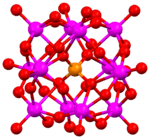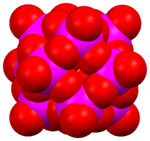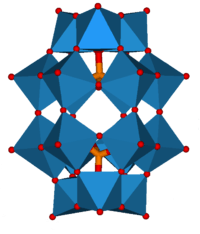Keggin structure
Keggin structure is the best known structural form for heteropoly acids. It is the structural form of α-Keggin anions, which have a general formula of [XM12O40]n−, where X is the heteroatom (most commonly are P5+, Si4+, or B3+), M is the addenda atom (most common are molybdenum and tungsten), and O represents oxygen.[1] The structure self-assembles in acidic aqueous solution and is the most stable structure of polyoxometalate catalysts.



History
The first α-Keggin anion, ammonium phosphomolybdate ((NH4)3[PMo12O40]), was first reported by Berzelius in 1826. In 1892, Blomstrand proposed the structure of phosphomolybdic acid and other poly-acids as a chain or ring configuration. Alfred Werner, using the coordination compounds ideas of Copaux, attempted to explain the structure of silicotungstic acid. He assumed a central group, [SiO4]4− ion, enclosed by four [RW2O6]+, where R is a unipositive ion. The [RW2O6]+ are linked to the central group by primary valences. Two more R2W2O7 groups were linked to the central group by secondary valences. This proposal accounted for the characteristics of most poly-acids, but not all.
In 1928, Linus Pauling proposed a structure for α-Keggin anions consisting of a tetrahedral central ion, [XO4]n−8, caged by twelve WO6 octahedra. In this proposed structure, three of the oxygen on each of the octahedra shared electrons with three neighboring octahedra. As a result, 18 oxygen atoms were used as bridging atoms between the metal atoms. The remaining oxygen atoms bonded to a proton. This structure explained many characteristics that were observed such as basicities of alkali metal salts and the hydrated form of some of the salts. However the structure could not explain the structure of dehydrated acids.
James Fargher Keggin with the use of X-ray diffraction experimentally determined the structure of α-Keggin anions in 1934. The Keggin structure accounts for both the hydrated and dehydrated α-Keggin anions without the need for significant structural change. The Keggin structure is the widely accepted structure for the α-Keggin anions.[2]
Structure and physical properties



The structure has full tetrahedral symmetry and is composed of one heteroatom surrounded by four oxygen atoms to form a tetrahedron. The heteroatom is located centrally and caged by 12 octahedral MO6-units linked to one another by the neighboring oxygen atoms. There are a total of 24 bridging oxygen atoms that link the 12 addenda atoms. The metal centres in the 12 octahedra are arranged on a sphere almost equidistant from each other, in four M3O13 units, giving the complete structure an overall tetrahedral symmetry. The bond length between atoms varies depending on the heteroatom (X) and the addenda atoms (M). For the 12–phosphotungstic acid, Keggin determined the bond length between the heteroatom and each the four central oxygen atoms to be 1.5 Å. The bond length form the central oxygen to the addenda atoms is 2.43 Å. The bond length between the addenda atoms and each of the bridging oxygen is 1.9 Å. The remaining 12 oxygen atoms that are each double bonded to an addenda atom have a bond length of 1.70 Å. The octahedra are therefore distorted.[3][4] This structure allows the molecule to hydrate and dehydrate without significant structural changes and the molecule is thermally stable in the solid state for use in vapor phase reactions at high temperatures (400−500 °C).[5]
Isomerism
Including the original Keggin structure there are 5 isomers, designated by the prefixes α-, β-, γ-, δ- and ε-. The original Keggin structure is designated α-. These isomers are sometimes termed Baker, Baker-Figgis or rotational isomers,[6] These involve different rotational orientations of the Mo3O13 units, which lowers the symmetry of the overall structure.
Lacunary Keggin structures
The term lacunary is applied to ions which have a fragment missing, sometimes called defect structures. Examples are the (XM11O39)n− and (XM9O34)n− formed by the removal from the Keggin structure of sufficient Mo and O atoms to eliminate 1 or 3 adjacent MO6 octahedra. The Dawson structure, X2M18O62n−, is made up of two Keggin lacunary fragments with 3 missing octahedra.

Group 13 cations with the Keggin structure
The cluster cation (Al13O4(OH)24(H2O)12)7+ has the Keggin structure with a tetrahedral Al atom in the centre of the cluster coordinated to 4 oxygen atoms. The formula can be expressed as (AlO4Al12(OH)24(H2O)12)7+.[7] This ion is generally called the Al13 ion. A Ga13 analogue is known[8] an unusual ionic compound with an Al13 cation and a Keggin polyoxoanion has been characterised.[9]
The iron Keggin ion
Due to the similar aqueous chemistries of aluminum and iron, it has been long thought that an analogous iron polycation should be isolatable from water. Moreover, in 2007, the structure of ferrihydrite was determined and shown to be built of iron Keggin ions.[10] This further captured scientists’ imagination and drive to isolate the iron Keggin ion. In 2015, the iron Keggin ion was isolated from water, but as a polyanion with a −17 charge; and protecting chemistry was required.[11] Iron-bound water is very acidic; so it is difficult to capture the intermediate Keggin ion form without bulky and nonprotic ligands instead of the water that is found in the aluminum Keggin ion. However, more important in this synthesis was the bismuth (Bi3+) counterions that provided high positive charge to stabilize the high negative charge of the heptadecavalent polyanion.
Chemical properties
The stability of the Keggin structure allows the metals in the anion to be readily reduced. Depending on the solvent, acidity of the solution and the charge on the α-Keggin anion, it can be reversibly reduced in one- or multiple-electron steps.[12] For example, silicotungstate anion can be reduced to 20th state.[13] Some anions such as silicotungstic acid are strong enough as an acid as sulfuric acid and can be used in its place as an acid catalyst.
Preparation
In general α-Keggin anions are synthesized in acidic solutions. For example, 12-Phosphotungstic acid is formed by condensing phosphate ion with tungstate ions. The heteropolyacid that is formed has the Keggin structure.[5]
- PO3−
4 + 12 WO2−
4 + 27 H+ → H3PW12O40 + 12 H2O
Uses
α-Keggin anions have been used as catalyst in the following reactions: hydration, polymerization and oxidation reaction as catalysts.[5] Japanese chemical companies have commercialized the use of the compounds in hydration of propene, oxidation of methacrolein, hydration isobutene, hydration of n-butene, and polymerization of THF.[14][15]
Suppliers
12-Phosphotungstic acid, the compound J.F. Keggin used to determine the structure, can be purchased commercially. Other compounds that contain the α-Keggin anion such as silicotungstic acid and phosphomolybdic acid are also commercially available at Aldrich Chemicals, Fisher Chemicals, Alfa Aesar, VWR Chemical, American Elements, etc.
References
- Housecroft, C. E.; Sharpe, A. G. (2004). Inorganic Chemistry (2nd ed.). Prentice Hall. pp. 660–662. ISBN 978-0-13-039913-7.
- J.C. Bailar, Jr. The Chemistry of the Coordination Compounds, Reinhold Publishing Corporation, 1956, pp 472-482
- J.F. Keggin. Proc. Roy. Soc., A, 144, 75-100 (1934)
- G.M. Brown; M.R. Noe-Spirlet; W.R. Bursing; H.A. Levy. Acta. Cryst. B33, 1038-1046 (1977)
- Y. Izumi; K. Urabe; M. Onaka. Zeolite, Clay, and Heteropoly Acid in Organic Reactions, Kodansha Ltd., Tokoyo 1992, pp 100-105
- A New Fundamental Type of Inorganic Complex: Hybrid between Heteropoly and Conventional Coordination Complexes. Possibilities for Geometrical Isomerisms in 11-, 12-, 17-, and 18-Heteropoly Derivatives. LCW Baker, JS Figgis Journal of the American Chemical Society 92(12), 3794-3797 (1970)
- Greenwood, Norman N.; Earnshaw, Alan (1997). Chemistry of the Elements (2nd ed.). Butterworth-Heinemann. ISBN 978-0-08-037941-8.
- Detection of a new polymeric species formed through the hydrolysis of gallium(III) salt solutions S. M. Bradley, R. A. Kydd and R. Yamdagni J. Chem. Soc., Dalton Trans., 1990, 413 - 417, doi:10.1039/DT9900000413
- New Ionic Crystals of Oppositely Charged Cluster Ions and Their Characterization Jung Ho Son and Young-Uk Kwon Inorg. Chem., 42 (13), 4153 -4159, (2003) doi:10.1021/ic0340377
- F. M. Michel, L. Ehm, S. M. Antao, et al. Science, 316, 1726-1729 (2007)
- O. Sadeghi, L. N. Zakharov and M. Nyman, Aqueous formation and manipulation of the iron-oxo Keggin ion Science; 2015; 347 (6228) pp 1359 - 1362; doi:10.1126/science.aaa4620
- T. Okuhara; N. Mizuno; M. Misono. Advances in Cayalysis, Vol 41: Catalytic Chemistry of Heteropoly Compounds. Academic Press Inc., 1996, pp 191-193
- M.T. Pope. Inorganic Chemistry Concepts 8: Heteropoly and Isopoly oxometalates. Springer-Verlag, Heidelberg, 1983, pp 101-107
- M.T. Pope; A. Müller. Polyoxometalates: From Platonic Solids to Anti—retroviral Activity. Kluwer Academic Publications, The Netherlands, 1994, pp 262-265
- T.J. Barton; L.M. Bull; W.G. Klemperer; D.A. Loy; B. McEnancy; M. Misono; etc. Chem. Mater. 11, 2633—2656 (1999)